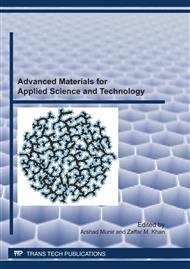[1]
Q.M. Zhang, H.F. Li, M. Poh, S.H. Xu, Z.Y. Cheng, F. Xia, C. Huang, An all-organic composite actuator material with a high dielectric constant, Nature, 419 (2002) 284-287.
DOI: 10.1038/nature01021
Google Scholar
[2]
Z.Y. Cheng, V. Bharti, T.B. Xu, T. Mai, Q.M. Zhang, Electrostrictive poly(vinylidene fluoride-trifluoroethylene) copolymers, Sensors and Actuators A: Phys. 90 (2001) 138-147.
DOI: 10.1016/s0924-4247(01)00496-4
Google Scholar
[3]
K. Ren, S. Liu, M. Lin, Y. Wang, Q.M. Zhang, A compact electroactive polymer actuator suitable for refreshable Braille display, Sensors and Actuators A: Phys. 143 (2008) 335-342.
DOI: 10.1016/j.sna.2007.10.083
Google Scholar
[4]
R. Pelrine, R. Kornbluh, Q.B. Pei, J. Joseph, High-speed electrically actuated elastomers with strain greater than 100%, Science, 287 (2000) 836-839.
DOI: 10.1126/science.287.5454.836
Google Scholar
[5]
R. Shankar, T.K. Ghosh, R.J. Spontak, Electroactive nanostructured polymers as tunable actuators, Adv. Mater. 19 (2007) 2218-2223.
DOI: 10.1002/adma.200602644
Google Scholar
[6]
C. Huang, Q.M. Zhang, G. deBotton, K. Bhattacharya, All-organic dielectric-percolative three-component composite materials with high electromechanical response, Appl. Phys. Lett. 84 (2004) 4391-4393.
DOI: 10.1063/1.1757632
Google Scholar
[7]
C. Huang, Q.M. Zhang, Enhanced dielectric and electricmechanical responses in high dielectric constant all-organic pervolative composites, Adv. Funct. Mater. 14 (2004) 501-506.
DOI: 10.1002/adfm.200305021
Google Scholar
[8]
C. Huang, Q.M. Zhang, Fully functionalized high-dielectric-constant nanophase polymers with high electromechanical response, Adv. Mater. 17 (2005) 1153-1158.
DOI: 10.1002/adma.200401161
Google Scholar
[9]
R. Popielarz, C.K. Chiang, R. Nozaki, J. Obrzut, Dielectric properties of polymer/ferroelectric ceramic composites from 100 Hz to 10 GHz, Macromolecules, 34 (2001) 5190-5915.
DOI: 10.1021/ma001576b
Google Scholar
[10]
H. Windlass, R.P. Markondeya, D. Balaraman, S. Bhattacharya, R. Tummala, Polymer-ceramic nanocomposite capacitors for system-on-package (SOP) applications, IEEE Trans Adv Pack. 26 (2003) 10-16.
DOI: 10.1109/tadvp.2003.811369
Google Scholar
[11]
M. Arbatti, X.B. Shan, Z.Y. Cheng, Ceramic–polymer composites with high dielectric constant, Adv. Mater. 19 (2007) 1369-1372.
DOI: 10.1002/adma.200601996
Google Scholar
[12]
C. Huang, Q.M. Zhang, J.Y. Li, M. Rabeony, Colossal dielectric and electromechanical responses in self-assembled polymeric nanocomposites, Appl. Phys. Lett. 87 (2005) 182901-3.
DOI: 10.1063/1.2105997
Google Scholar
[13]
C.C. Wang, Q.D. Shen, S.C. Tang, Q. Wu, H.M. Bao, C.Z. Yang, X.Q. Jiang, Ferroelectric polymer nanotubes with large dielectric constants for potential all-organic electronic devices, Macromol. Rapid commun. 29 (2008) 724-728.
DOI: 10.1002/marc.200800022
Google Scholar
[14]
J.W. Wang, Q.D. Shen, C.Z. Yang, High dielectric constant composite of P(VDF-TrFE) with grafted copper phthalocyanine oligomer, Macromolecules, 37 (2004) 2294-2298.
DOI: 10.1021/ma035685c
Google Scholar
[15]
J.W. Wang, Q.D. Shen, H.M. Bao, C.Z. Yang, Microstructure and dielectric properties of P(VDF-TrFE-CFE) with partially grafted copper phthalocyanine oligomer, Macromolecules, 38 (2005) 2247-2252.
DOI: 10.1021/ma047890d
Google Scholar
[16]
B.N. Achar, G.M. Fohlen, J.A. Parker, Phthalocyanine polymers. II synthesis and characterization of some metal phthalocyanine sheet oligomers, J. Polym. Sci. Polym. Chem. 20 (1982) 1785-1789.
DOI: 10.1002/pol.1982.170200711
Google Scholar
[17]
J.Y. Li, Exchange coupling in P(VDF-TrFE) copolymer based all-organic composites with giant electrostriction, Phys. Rev. Lett. 90 (2003) 217601-4.
DOI: 10.1103/physrevlett.90.217601
Google Scholar
[18]
I. Diaconu, D.O. Dorohoi, F. Topoliceanu, Electrostriction of a Polyurethane Elastomer-Based Polyester, IEEE Sens. J. 6 (2006) 876-880.
DOI: 10.1109/jsen.2006.877978
Google Scholar
[19]
H.S. Choi, S.T. Noh, Preparation and characterization of N-methyl-substituted polyurethane, J. Polym. Sci. Polym. Chem. 40 (2002) 4077-4083.
DOI: 10.1002/pola.10492
Google Scholar
[20]
S. Nemat-Nasser, J.Y. Li, Electromechanical response of ionic polymer-metal composites, J. Appl. Phys. 87 (2000) 3321-3331.
DOI: 10.1063/1.372343
Google Scholar


